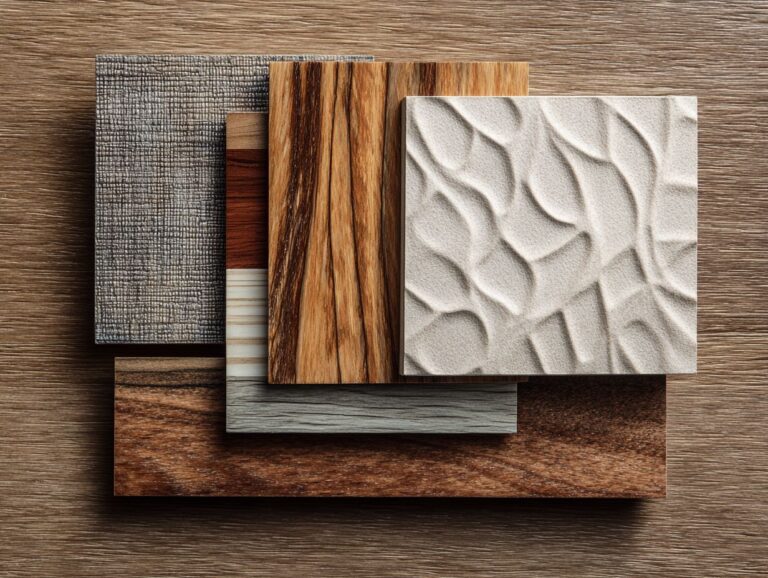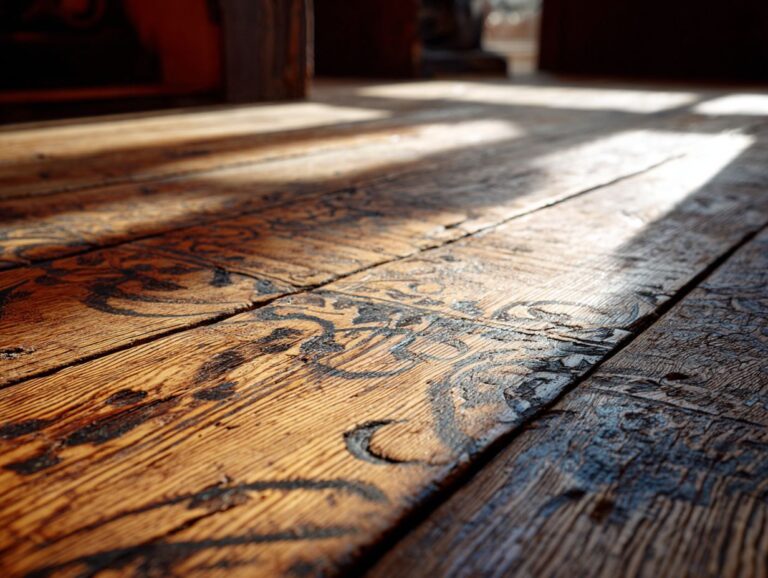Tile PEI Ratings Explained – Choosing the Right Durability
Picking the right tile product can greatly affect your space, and knowing PEI ratings helps guarantee it lasts against surface wear. The Porcelain Enamel Institute (PEI) provides a standardized rating system that helps you assess the quality of glazed tiles. In this article, we’ll break down PEI ratings, their importance, and how to select the best tile for your needs, ensuring your choice stands the test of time.
Key Takeaways:
Contents
What is PEI?
PEI, or Porcelain Enamel Institute, is an organization that develops standards for the durability of ceramic and porcelain tiles, contributing significantly to consumer knowledge.
PEI ratings range from I to V, indicating varying levels of durability suited for different environments. For example, a PEI Class I tile is good for light home use, like in bathrooms, whereas a Class IV tile can handle moderate business use, making it ideal for entryways.
When choosing tiles, buyers should think about the installation location: for places with heavy use, choose Class III or IV tiles to last longer. This information guides homeowners and builders in choosing the best tile for their needs, ensuring it is both attractive and functional.
Importance of PEI Ratings
PEI Ratings help you choose tiles by showing how strong they are and how they might hold up in places where lots of people walk.
PEI Ratings range from I to V, where I is suitable for walls and V is ideal for high-traffic commercial floors.
For example, if you’re tiling a residential kitchen, look for tiles rated III or higher, ensuring they can withstand the wear of daily use. In contrast, for a retail space, tiles rated IV or V offer superior durability against heavy foot traffic.
Tools like the PEI Rating chart can help you easily compare options, leading to a more informed and durable choice.
Understanding the PEI Rating Scale
The PEI Rating Scale classifies tiles from 1 to 5 according to how well they resist surface wear, offering a consistent way to judge how tiles hold up. This rating becomes particularly insightful when assessing the differences in durability between porcelain and ceramic tiles, which are commonly compared in the flooring industry.
Tile PEI Ratings Statistics
Tile PEI Ratings Statistics
PEI Rating Utilization: PEI Rating Utilization
The Tile PEI Ratings Statistics Offer a useful guide for knowing how to choose tiles based on how strong they are and what they are meant for. The PEI (Porcelain Enamel Institute) rating system sorts tiles by how well they resist wear and scratches. This is an important guide for architects, builders, and homeowners when choosing tiles for different settings.
PEI Rating Utilization outlines five distinct categories:
- PEI 1 (Light Residential Use): Rated at 1.0, these tiles are suitable for areas subject to minimal foot traffic, such as bathroom walls or countertops. Their delicate nature makes them ideal for spaces where durability is less of a concern.
- PEI 2 (Moderate Residential Use): With a rating of 2.0, these tiles are designed for floors in residential spaces like bedrooms or living rooms where moderate wear is anticipated. They strike a balance between aesthetics and functionality.
- PEI 3 (Heavy Residential and Light Commercial Use): With a 3.0 rating, these tiles are suitable for homes with a lot of foot traffic and small commercial areas, like small offices. Their durability helps them look good even after regular use.
- PEI 4 (Light Commercial Use): Rated at 4.0, these tiles are appropriate for areas with significant foot traffic, such as retail stores or offices. Their sturdiness ensures they last a long time and resist damage in busy places.
- PEI 5 (Heavy Commercial Use): At the top of the scale, with a rating of 5.0, these tiles can withstand heavy commercial use, including airports or shopping malls. Their exceptional durability is essential for areas with constant, intense use.
Knowing these ratings helps you pick the right tiles, making sure they match the design and last a long time. Using PEI ratings correctly improves the use and durability of tiled surfaces, making better use of the materials purchased.
PEI Rating Levels Explained
PEI Ratings range from 1 to 5, where 1 is suitable only for wall applications and 5 is designed for heavy foot traffic in commercial areas.
The PEI Rating Scale helps consumers choose the right flooring based on their needs.
A PEI rating of 1 is perfect for bathroom walls in homes because it handles moisture well, even though it’s not meant for areas with a lot of foot traffic. A rating of 3, in contrast, suits moderate residential areas, like kitchens or hallways.
For high-traffic settings, such as office lobbies or retail spaces, consider a rating of 5 for durability.
Assess your space’s specific requirements-such as expected traffic and water exposure-to make an informed choice.
How Ratings are Determined
PEI Ratings are determined through standardized testing procedures, including the rotary abrasion test, which assesses durability under simulated wear conditions.
This test involves placing a sample material on a rotary platform, subjecting it to abrasive conditions while measuring the wear it undergoes.
Additional tests, such as the impact resistance test and water absorption test, also contribute to the overall PEI Rating. Ratings are assigned on a scale from 0 to 5, where a score of 5 indicates exceptional durability.
To carry out the task, make sure your testing lab has essential tools like a wear index gauge and an impact tester. These will help you get correct results and select suitable materials.
Choosing the Right Tile for Your Space
Choosing the right tile means knowing how it will be used and checking that it looks good and lasts long.
Residential vs. Commercial Use
When selecting tiles, it’s important to know the difference between tiles for homes and for businesses. Tiles in commercial spaces need to be more durable.
For residential applications, tiles with a PEI Rating of 1 to 3 are generally suitable, ideal for areas with light foot traffic, such as bathrooms and kitchens.
In contrast, commercial spaces, like retail stores or restaurants, benefit from tiles rated 4 to 5, as these can withstand heavy traffic and frequent cleaning. For example, a caf might opt for a PEI 4 porcelain tile, providing both aesthetic appeal and durability, whereas a lobby in a corporate office could use PEI 5 tiles for optimal resilience.
High Traffic Areas
High traffic areas require tiles with higher PEI ratings to withstand continuous foot traffic without degrading in appearance or performance.
For residential settings, consider using PEI 4 tiles in entryways and kitchens, as they can handle significant wear from shoes and movement.
In commercial spaces such as retail stores or restaurants, opt for PEI 5 tiles, which excel under the demands of high foot traffic and frequent cleaning.
Brands like Porcelanosa and Daltile offer durable options specifically designed for these settings.
By using these ratings, you can make sure that the product lasts a long time and looks good, which means you won’t have to fix or replace it often.
Wet Areas Considerations
Choosing tiles for places like bathrooms and kitchens involves checking both PEI ratings and slip resistance for safety and long-lasting use.
- Start by choosing tiles with a minimum slip-resistance rating of R10, as these provide adequate grip, especially when wet. Materials like porcelain and textured ceramic are excellent choices, offering both durability and water resistance.
- Opt for tiles with a low water absorption rate of less than 0.5% to prevent moisture damage. Consider the use of matting or safety strips in areas prone to high water exposure for extra protection.
- Popular brands like Daltile and Mohawk offer collections specifically designed for wet environments, ensuring both aesthetic appeal and safety.
PEI Ratings and Tile Materials
Different tile materials, like ceramic, porcelain, and natural stone, have distinct features that affect their PEI Ratings and how well they fit for use.
Ceramic Tiles
Ceramic tiles typically carry lower PEI ratings but offer excellent aesthetic options for residential applications, especially in low to moderate traffic areas.
These tiles are perfect for kitchens, bathrooms, and living rooms where design is important.
For example, a PEI rating of III means the tile can handle medium foot traffic, which makes it suitable for homes in places like hallways and dining rooms.
While they may not be the best choice for high-traffic commercial spaces, their versatility shines in decorative features such as backsplashes and accent walls.
Use long-lasting grouts and sealants to make them last longer and keep them looking good.
Pores and Glazes
The porosity and glazing of tiles significantly affect their durability, maintenance requirements, and overall performance in various environments.
Glazes make tiles last longer by providing a protective coat that makes them less absorbent. For example, a glossy glaze may yield a lower PEI rating, indicating it’s more suitable for light residential use, while a matte finish might withstand heavier foot traffic and higher PEI ratings.
Cleaning maintenance also varies: glossy tiles are easier to wipe down but may show scratches more readily, whereas textured finishes can trap dirt, requiring more effort to clean.
Choosing the appropriate glaze means finding a balance between how it looks and how well it works, so it lasts a long time.
Stone Tiles
Natural stone tiles are durable and unique, making them a great option for both homes and businesses when they are installed correctly.
These tiles come in various types such as granite, marble, and slate, each bringing its own characteristics. For instance, granite is highly durable, ideal for high-traffic areas, whereas marble, while stunning, requires more maintenance.
Installation involves ensuring a suitable substrate; a cement backer board is recommended for wet areas. Use thin-set mortar for stronger sticking and choose grout that matches the tile for a good look.
A well-installed natural stone tile can last a lifetime, provided it’s cared for properly, ensuring lasting beauty and performance.
Common Misconceptions About PEI Ratings
People often misunderstand PEI Ratings, particularly regarding their connection to tile quality and how tiles work in different situations.
Higher Rating Equals Better Quality
A higher PEI Rating does not automatically indicate better quality; it reflects suitability for specific environments rather than overall tile performance.
For example, while a tile with a PEI Rating of 4 may be durable and ideal for heavy foot traffic in commercial spaces, it might not be necessary for a low-traffic residential bathroom, where a PEI Rating of 2 could suffice.
Think about the space: choose stronger tiles for busy or wet areas, such as entryways or kitchens, and go for softer ones in bedrooms or hallways.
Assess your specific needs before choosing the ideal tile, ensuring a balance between performance and aesthetics.
PEI and Slip Resistance
The PEI Rating system focuses primarily on wear resistance, not slip resistance, which can lead to confusion when selecting tiles for wet areas.
Knowing the differences between PEI Ratings and slip resistance measures like the Coefficient of Friction (COF) is important for safety.
PEI Ratings, ranging from 1 to 5, assess how well a tile can withstand abrasion and traffic, but they do not indicate how slippery a tile might be. On the other hand, COF values, derived from standardized tests, measure how much friction a surface provides when wet.
For optimal safety in areas like bathrooms or kitchens, aim for tiles with a PEI rating of at least 4 combined with a COF of 0.6 or higher.
Practical Tips for Selecting Tiles
When choosing tiles, practical advice can simplify the process and help make sure the selected tiles meet all required functional and visual standards.
Assessing Your Needs
Evaluating your unique needs, such as how much traffic the area gets and environmental conditions, is important for selecting the right tiles.
- Start by evaluating your traffic volume; high-traffic areas benefit from durable, high-slip resistance tiles, such as porcelain or ceramic.
- Consider environmental factors too-outdoor areas exposed to moisture might require anti-slip tiles, like natural stone or textured vinyl.
- Consider the climate of your area; in warmer places, choose lighter-colored tiles to reflect heat, and in cooler areas, opt for darker tiles to retain warmth.
- Think about the style and functionality; for example, mosaics can add a decorative touch in kitchens or bathrooms, while large format tiles create a seamless look in living spaces.
Consulting with Professionals
Talking to tile experts can give you helpful advice and suggestions suited to what you need for your project.
For instance, a professional can assess your space and suggest the right types of tiles, such as porcelain for durability or glass for a sleek look. They can also guide you in selecting grout colors that complement your tiles.
By utilizing tools like design software or tile visualizers, professionals can create mock-ups, helping you visualize the finished project. Their knowledge helps make your decisions easier and makes sure your choices look good and work well.
Recap of Key Points
To recap, PEI Ratings provide essential guidance in selecting tiles that meet your specific needs for durability and aesthetic appeal.
The PEI rating scale ranges from 0 to 5, with 0 being unsuitable for floors and 5 indicating heavy-duty use. For example, a PEI rating of 3 is perfect for residential areas with light foot traffic, while a rating of 5 is ideal for commercial spaces requiring high durability.
When choosing tiles, consider factors like moisture resistance for bathroom areas or color and texture to match your home’s decor.
Tools such as online tile calculators can also help you estimate the quantity you’ll need based on your space dimensions.
Final Thoughts on Tile Durability
Picking sturdy tiles can make your area look better and last longer, while cutting down on maintenance costs later.
When choosing tiles, think about the material, how much upkeep they need, and where they will be used.
Porcelain tiles are very strong and do not absorb water easily, which makes them perfect for use in bathrooms and kitchens. On the other hand, natural stone tiles, while beautiful, may require regular sealing to protect against stains.
Assess the traffic levels in the area; high-traffic zones benefit from tougher options like ceramic. By focusing on these factors, you choose wisely, combining good looks with long-lasting quality, which saves time and money over time.
Additional Resources
For readers looking for more information about choosing tiles, many resources can give clear details and advice on PEI Ratings and best practices.
Further Reading on Tile Selection
Look at more materials on choosing tiles, like guides from the Porcelain Enamel Institute and industry magazines, to learn more.
Look at these well-known sources for thorough information:
- The Tile Council of North America offers guidelines on installation practices.
- The National Tile Contractors Association features articles on the latest trends and techniques.
- Industry standards can be found in resources like ANSI (American National Standards Institute) specifications.
These sources help you pick the right tile and provide important information on how to properly check PEI ratings, ensuring your choices meet the required strength and quality.
Frequently Asked Questions
What do PEI ratings mean for tiles?
PEI ratings are a measure of a tile’s durability and ability to withstand foot traffic and wear. They help you choose the right tile for your specific needs.
What are the different levels of PEI ratings?
The five levels of PEI ratings range from 0 to 5, with 0 being the least durable and 5 being the most durable. Each level is designed for a specific level of foot traffic and wear.
How do I determine the right PEI rating for my project?
Consider the level of foot traffic in the area where you’re installing the tiles. For high-traffic areas, such as commercial spaces, a PEI rating of 4 or 5 is recommended. For low-traffic areas, a rating of 0 or 1 may suffice.
Can a lower PEI rating be used in high-traffic areas?
While it is not recommended, a lower PEI rating can still be used in high-traffic areas if the tile is well-maintained and cleaned regularly. But, it’s always better to select a higher rating for strength and lifespan.
Do all types of tiles have PEI ratings?
No, not all types of tiles have PEI ratings. This rating system is most commonly used for glazed ceramic and porcelain tiles, but it may also be applied to natural stone and some other materials.
What factors should I consider when choosing the right PEI rating?
In addition to foot traffic, consider other factors such as the size and weight of the tiles, the type of surface they will be installed on, and the type of wear they will be exposed to (e.g. shoes, furniture, etc.). These can all affect the durability and longevity of the tiles.




